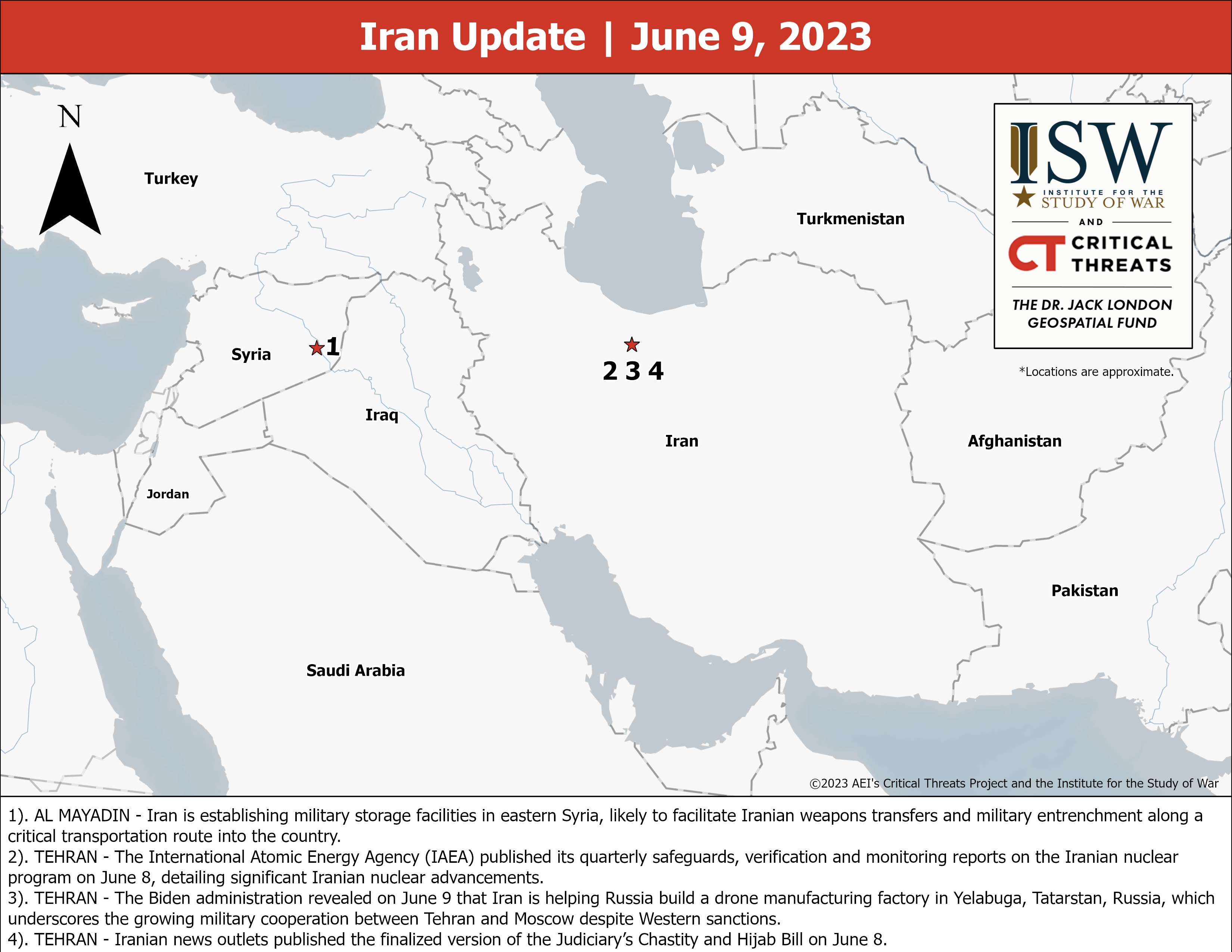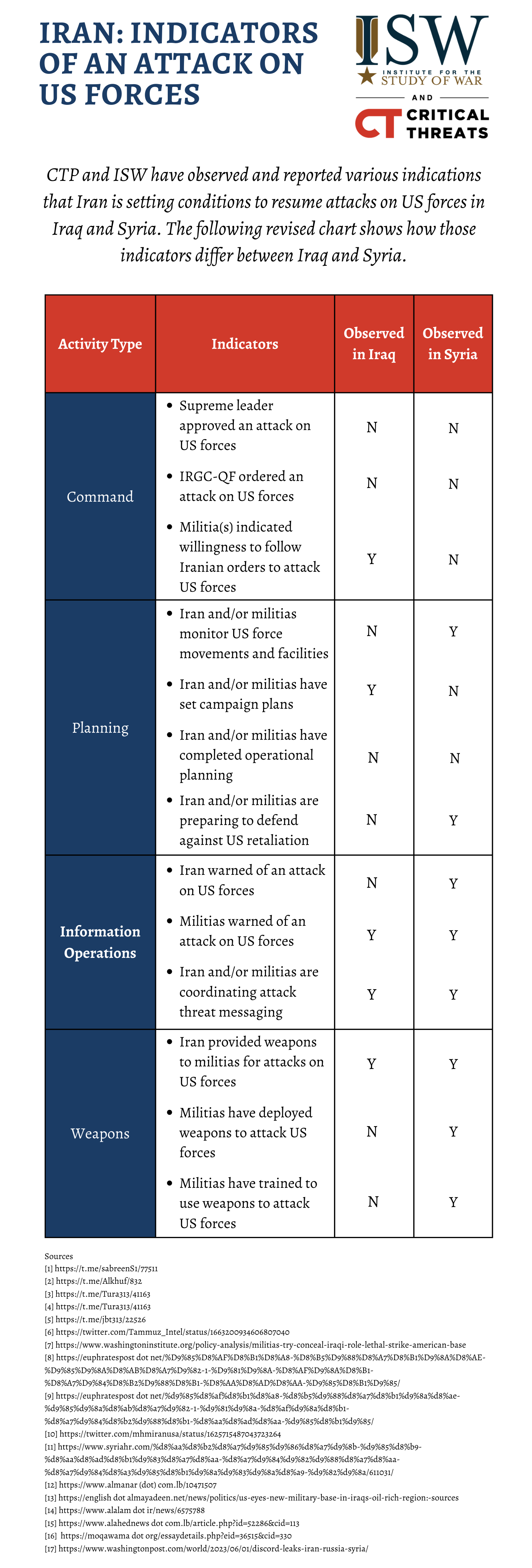{{currentView.title}}
June 09, 2023
Iran Update, June 9, 2023
The Iran Update aims to inform national security policy by providing timely, relevant, and independent open-source analysis of developments pertaining to Iran and its Axis of Resistance. This update covers political, military, and economic events and trends that affect the stability and decision-making of the Iranian regime. It also provides insights into Iranian and Iranian-sponsored activities abroad that undermine regional stability and threaten US forces and interests. The Critical Threats Project (CTP) at the American Enterprise Institute with support from the Institute for the Study of War (ISW) provides these updates Monday through Friday. To receive Iran Updates via email, please subscribe here.
The Institute for the Study of War (ISW) with support from the Critical Threats Project (CTP) at the American Enterprise Institute is launching a new interactive map of Iran and the Middle East. The map depicts events in Iran that affect the stability of the Iranian regime, namely anti-regime protests and reported poisoning incidents. It also shows developments in Syria that jeopardize regional stability and pose threats to US forces and interests, including Iranian and Iranian-backed militia positions.
Key Takeaways
- Iran is establishing military storage facilities in eastern Syria, likely to facilitate Iranian weapons transfers and military entrenchment along a critical transportation route into the country. These construction projects are part of a larger Iranian effort to build military infrastructure throughout Deir ez Zor Province.
- The International Atomic Energy Agency (IAEA) published its quarterly safeguards, verification and monitoring reports on the Iranian nuclear program on June 8, detailing significant Iranian nuclear advancements. The IAEA reports furthermore demonstrate that Iran has not resolved any of the agency’s inquiries into undeclared nuclear activities—contrary to recent Western media reports.
- The Biden administration revealed on June 9 that Iran is helping Russia build a drone manufacturing factory in Yelabuga, Tatarstan, Russia, which underscores the growing military cooperation between Tehran and Moscow despite Western sanctions.
- Iranian news outlets published the finalized version of the Judiciary’s Chastity and Hijab Bill on June 8. This bill demonstrates the regime’s uncompromising stance on women’s rights issues and continued refusal to grant sociocultural concessions in the aftermath of the Mahsa Amini movement.

Iranian Activities in the Levant
This section covers Iranian efforts to consolidate and expand Tehran’s economic, military, and political influence throughout the Levant and especially in Syria. This section examines some of the many campaigns that Iran is pursuing to achieve this strategic objective. CTP will update and refine our assessments of these campaigns over time and in future updates.
Iran is establishing military storage facilities in eastern Syria, likely to facilitate Iranian weapons transfers and military entrenchment along a critical transportation route into the country. A senior Islamic Revolutionary Guards Corps (IRGC) official in al Mayadin ordered Lebanese Hezbollah-run, US-sanctioned construction company Jihad al Binaa to excavate land for weapons warehouses and tunnels in eastern al Mayadin, according to local anti-Iranian outlet Eye of Euphrates on June 8.[i] Separately, Iranian-backed militants transported a large construction crane to dig tunnels and build warehouses near the Ain Ali Shrine in the southern outskirts of al Mayadin on May 31.[ii]These construction projects are part of a larger Iranian effort to build military infrastructure throughout Deir ez Zor Province. CTP previously reported Jihad al Binaa and the IRGC built a barracks, weapons storage facility, training camp, and dozens of houses for families of Iranian-affiliated militants in Deir ez Zor City on May 19.[iii] Iran stores advanced weapons in underground sites to protect the materiel from detection and destruction, especially from Israeli airstrikes, indicating Iran intends to build up an advanced weapons stockpile in al Mayadin.[iv] Iranian-backed militias have previously targeted US forces from al Mayadin.[v]
CTP presents here an updated graphic illustrating the observed and unobserved indicators that we are using to understand whether Iran will resume its attack campaigns in Iraq and Syria to expel US forces. We will update and refine this list and our related assessments in future updates.
 CTP modified this list of indicators to refine our efforts to forecast whether Iran will direct an attack on US forces in Iraq and Syria. We removed indicators related to new military infrastructure, weapons shipments, and IRGC Quds Force operations in Iraq and Syria because these phenomena are not solely indicative of an impending campaign to target US forces. Iran is pursuing multiple strategic and operational objectives in Iraq and Syria through human networks and with military infrastructure that it has developed over time and under multiple campaigns. CTP can therefore not determine whether new military infrastructure, arms transfers, or IRGC Quds Force deployments are meant for an Iranian campaign to expel US forces from Iraq and Syria.
CTP modified this list of indicators to refine our efforts to forecast whether Iran will direct an attack on US forces in Iraq and Syria. We removed indicators related to new military infrastructure, weapons shipments, and IRGC Quds Force operations in Iraq and Syria because these phenomena are not solely indicative of an impending campaign to target US forces. Iran is pursuing multiple strategic and operational objectives in Iraq and Syria through human networks and with military infrastructure that it has developed over time and under multiple campaigns. CTP can therefore not determine whether new military infrastructure, arms transfers, or IRGC Quds Force deployments are meant for an Iranian campaign to expel US forces from Iraq and Syria.
CTP is unlikely to observe some of the indicators in the open-source environment, such as Iran’s supreme leader approving attacks and the IRGC Quds Force commander ordering Iranian-backed militias to conduct the attacks. It would also be abnormal for Iraqi outlets to cover Iranian-backed proxies receiving arms from Iran or deploying those weapons for use against US forces.
CTP cannot currently determine which proxy groups Iran would direct to attack US forces. The list of indicators is designed to assess whether Iran and its proxies have set the conditions needed to begin an attack campaign against US forces from Iraq and Syria. This list does not determine which proxies Iran would direct to carry out attacks or which militias might conduct attacks of their own volition. Iranian-backed proxies employ façade groups to obfuscate their involvement in attacks. It is also unclear which of the groups that have announced plans to attack US forces intend to follow through on their threats. Uniform messaging across Iranian-backed proxies supports CTP’s assessment that Iran intends to pursue this campaign, but proxies do not consistently follow through on threats to US forces.
Iranian Domestic Affairs
This section covers factors and trends affecting regime decision-making and stability. CTP will cover domestic politics, significant protest activity, and related issues here.
The International Atomic Energy Agency (IAEA) published its quarterly safeguards, verification and monitoring reports on the Iranian nuclear program on June 8, which detail significant Iranian nuclear advancements. Iran has accumulated 114.1 kilograms of 60-percent enriched uranium—more than quadruple the amount that the IAEA considers a “significant quantity” of highly enriched uranium needed to produce a single compact nuclear explosive.[vi] Iran’s total stockpile of enriched uranium is over 14 times the permitted limit of the Joint Comprehensive Plan of Action.[vii] Iran could enrich one bomb’s worth of weapons-grade uranium in 12 days and eight bombs’ worth in three months given its current stockpile and number of operating advanced centrifuges.
The IAEA reports furthermore demonstrate that Iran has not resolved any of the agency’s inquiries into undeclared nuclear activities—contrary to recent Western media reports. Iran provided information for its claim that the near weapons-grade uranium discovered at the Fordow enrichment facility in January 2023 was due to an unintended fluctuation in enrichment levels.[viii] The IAEA assessed that the information was “not inconsistent” with Iran’s explanation. The agency typically uses that language when it is unpersuaded and plans on further pursuing its investigation.[ix] The agency also stated that Iran provided one “possible explanation” for the discovery of enriched uranium traces at the undeclared Marivan site, meaning that the agency could not verify Iran’s explanation and will consider alternatives over time.[x] Western and Iranian media incorrectly reported that Iran had resolved both of the above inquiries.[xi] Iran also did not provide a satisfactory explanation for the discrepancy in its natural uranium inventory at the conversion facility in Esfahan.[xii] Iran could have been trying to conceal nuclear weapons-related activities by mixing diverted natural uranium back into its Esfahan inventory.[xiii] Iran has also not provided any explanations for the outstanding safeguards issues surrounding the Turquzabad and Varamin sites.[xiv]
The Biden administration revealed on June 9 that Iran is helping Russia build a drone manufacturing factory in Yelabuga, Tatarstan, Russia, which underscores the growing military cooperation between Tehran and Moscow despite Western sanctions.[xv] National Security Council spokesperson John Kirby stated on June 9 that the drone factory—which the Wall Street Journal reported in February 2023 could produce at least 6,000 Iranian Shahed-136 drones—could be operational by early 2024.[xvi] Kirby previously announced on May 15 that Russia is seeking to purchase new drones from Iran after expending most of its Iranian drone supply.[xvii] A factory producing Iranian drones in Russia would support Russia’s war effort against Ukraine. Russia could provide Iran with advanced military equipment that would help modernize Iran’s armed forces, such as Su-35 fighter jets, attack helicopters, radars, and YAK-130 combat trainer aircraft, in return for helping construct the factory.
Iranian news outlets published the finalized version of the Judiciary’s Chastity and Hijab Bill on June 8. This bill demonstrates the regime’s uncompromising stance on women’s rights issues and continued refusal to grant sociocultural concessions in the aftermath of the Mahsa Amini movement. The Raisi administration approved this bill drafted by the Judiciary outlining the regime’s hijab enforcement policy on May 21.[xviii] Parliamentarians are currently reviewing the bill, although it is unclear when they will vote on it. The bill outlines numerous legal punishments for noncompliance with the hijab law, including fines, salary cuts, deprivation of “social rights,” and referral to judicial authorities.[xix] The bill additionally stipulates that Iranian authorities can shut down public places—such as stores and restaurants—where mandatory veiling is not observed. CTP has previously observed Iranian authorities using and threatening such punishments to compel compliance with the hijab law.[xx] The provisions of the new Chastity and Hijab Bill are thus not new but demonstrate the regime’s resolve to crack down—as opposed to compromise—on sociocultural issues following the Mahsa Amini movement.
[i] https://eyeofeuphrates[dot]com/index.php/ar/news/2023/06/08/8771
[ii] https://eyeofeuphrates[dot]com/index.php/ar/news/2023/05/31/8684
[iii] https://www.criticalthreats.org/analysis/iran-update-may-22-2023
[iv] https://halabtodaytv[dot]net/archives/229982
[v] https://euphratespost [dot] net/%d9%87%d8%ac%d9%80-%d9%80%d9%88%d9%85-%d8%a8%d8%b5%d9%80-%d9%80%d9%88%d8%a7%d8%b1%d9%8a%d8%ae-%d9%83%d8%a7%d8%aa%d9%8a%d9%88%d8%b4%d8%a7-%d8%b9%d9%84%d9%89-%d9%82%d8%a7%d8%b9%d9%80/
[vi] https://www.iaea.org/sites/default/files/23/06/gov2023-24.pdf ; https://www.iaea.org/sites/default/files/iaea_safeguards_glossary.pdf
[vii] https://www.iaea.org/sites/default/files/23/06/gov2023-24.pdf ; https://www.armscontrol.org/factsheets/JCPOA-at-a-glance
[viii] https://www.iaea.org/sites/default/files/23/06/gov2023-24.pdf
[ix] https://www.armscontrol.org/blog/2020-09-10/iaea-report-notes-progress-investigation ; https://www.iaea.org/sites/default/files/20/11/gov2020-41.pdf
[x] https://www.iaea.org/sites/default/files/23/06/gov2023-26.pdf
[xi] https://apnews.com/article/iran-nuclear-program-iaea-uranium-enrichment-dded37dd0509ff0f469478b5db771027 ; https://apnews.com/article/iran-nuclear-iaea-uranium-enrichment-us-998719beb4b3ae85738b52d01f7f6c44 ; https://www.reuters.com/world/middle-east/iaea-resolves-nuclear-issues-with-iran-iranian-media-2023-05-30/
[xii] https://www.iaea.org/sites/default/files/23/06/gov2023-24.pdf ; https://www.iaea.org/sites/default/files/23/06/gov2023-26.pdf
[xiii] https://www.wsj.com/articles/u-n-agency-confirms-iran-produced-enriched-uranium-close-to-weapons-grade-7ccd4069 ; https://isis-online.org/isis-reports/detail/iran-defies-the-international-atomic-energy-agency/ ; https://isis-online.org/isis-reports/detail/neutron-source-irans-uranium-deuteride-neutron-initiator-1/
[xiv] https://www.iaea.org/sites/default/files/23/06/gov2023-26.pdf
[xv] https://apnews.com/article/russia-iran-drone-factory-ukraine-war-dfdfb4602fecb0fe65935cb24c82421a?taid=648332c1137e400001afdb25&utm_campaign=TrueAnthem&utm_medium=AP&utm_source=Twitter
[xvi] https://www.wsj.com/articles/moscow-tehran-advance-plans-for-iranian-designed-drone-facility-in-russia-11675609087
[xvii] https://www.pbs.org/newshour/world/russia-is-seeking-more-attack-drones-from-iran-after-depleting-stockpile-white-house-says
[xviii] https://www.farsnews dot ir/news/14020227000252
[xix] https://www.entekhab dot ir/fa/news/729208
[xx] https://www.criticalthreats.org/analysis/iran-update-march-14-2023 ;
https://www.criticalthreats.org/analysis/iran-update-april-25-2023
